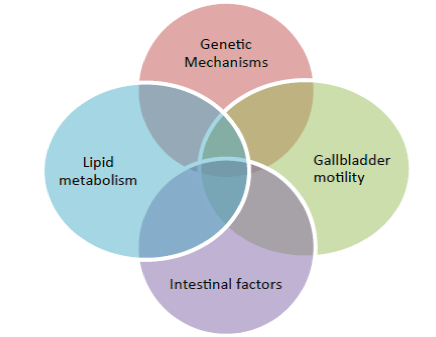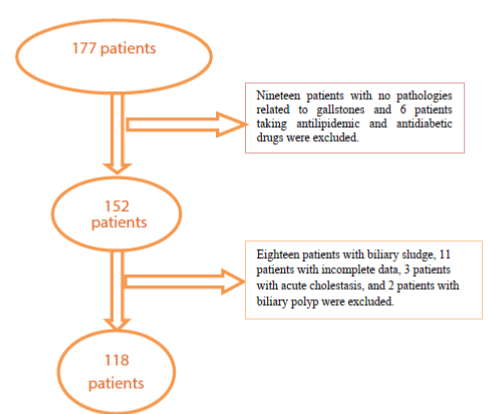Keywords
Gallstones, Sludge, lipid metabolism, Cholestasis, High-Density Lipoprotein, Low-Density Lipoprotein
Introduction
As shown in the investigations of Chinese and Egyptian mummies, gallstones are believed to have existed for 3,500 years [1]. In the modern world, the prevalence of gallstones is continuously increasing and believed to be around 10-15% [2]. Moreover, gallstone surgeries are the most commonly performed forms of abdominal surgeries [1].
Gallstones are divided into two groups based on their cholesterol content: cholesterol stones and pigment stones [1]. Though still debated, gallstones result from an interaction among 4 factors: genetic mechanisms, lipid metabolism, gallbladder motility, and intestinal factors, [1,3] (Figure 1).

Figure 1: Possible factors affecting gallstone formation.
The exact mechanism of gallstone formation, the type and number of stones, and the interaction among these 4 factors remain unknown. Among these factors, serum lipid profile (lipid metabolism) has been commonly associated with gallstones, particularly with the cholesterol stones; however, the results obtained are highly controversial [1,4-7]. Lipid profile does not differ greatly between the patients with cholesterol and pigment stones; however, the lipid profiles of the patients with cholesterol stones are believed to yield higher values than the normal ones [1,8].
Cholesterol stones may present as yellow or white and as single or multiple, whereas the pigment stones may be present as black or brown and mostly as multiple [1,2]. Previous studies have investigated the relationship between the number of gallstones, gallstone diseases, and, more commonly, gallbladder cancer [9,10]. However, no study has investigated whether the number of stones is completely dependent on chance or is a result of a complex interaction among the factors affecting gallstone formation. This study is the first to report the mechanism of stone formation and the hypothesis of the study is that this mechanism results from the complex interaction and the lipid profile is the main factor affecting the number of stones. To justify this hypothesis, the design in this study was constructed at a basic level. In this cross-sectional study, we aimed to investigate the effect of lipid profile, age, type of stone, and gender on the number of stones
Materials and Methods
Study design
The study was undertaken at Van District Training and Research Hospital between March and September, 2014. A total of 177 patients with an initial diagnosis of symptomatic or asymptomatic cholelitiasis were included into the study. A written consent was obtained from each patient. Following the detection of gallbladder stone, sludge, and cholestasis, all the patients were retrospectively followed up by two surgeons. All the patients were aged >16 years. Preoperative lipid profiles; triglyceride, total cholesterol, High-Density Lipoprotein (HDL), Low-Density lipoprotein (LDL), and Very Low-Density Lipoprotein (VLDL) were assessed via intravenously injected blood samples.
All the patients underwent cholecystectomy under elective conditions. The gallbladder was incised and the gallstones were exposed. The number of stones (single or multiple) in each gallbladder was recorded and the stones were morphologically classified as cholesterol or pigment. The patients who had biliary sludge, those with no gallstones, the ones who had polyps, the ones taking antidiabetic and antilipidemic drugs, the ones with incomplete data, and also, considering the potential effect of inflammation on the lipid profile, the patients with acute cholelitiasis were excluded from the study. As a result, 118 patients were studied (Figure 2).

Figure 2: An algorithm showing the process of patient inclusion.
Statistical analysis
All the data were analyzed using SPSS 20.0 (Chicago, IL, USA). Age, gender, lipid profile, and the number and type of stones were recorded. In multivariate analysis, the logistic regression test was used for the prediction of the number of stones (single or multiple) by using the possible factors defined by earlier studies.
Normal distribution was tested using visual (histogram and likelihood graphics) and analytic (Kolmogorov-Smirnov/Shapiro- Wilk tests) methods. The variables with normal distribution were expressed as means ± standard deviation (SD) and the ones with non-normal distribution were expressed with median and interquartile range.
The number of stones was analyzed by single variable analysis using student t-test, Chi-square test, Fisher’s-exact test and Mann-Whitney U test, as appropriate. In multivariate analysis, the logistic regression test was used for the prediction of the number of stones by using the probability factors defined by earlier studies. Model fit was tested using the Hosmer–Lemeshow statistic. A p value of <0.05 was considered significant.
Results
The 118 patients comprised 91 (77.1%) female and 27 (22.9%) male patients. Mean age was 45 years in females and 49 years in males (p=0.189). Table 1 presents the comparison of patient characteristics (gender, lipid profile, and type of stone) according to the number of stones. The number of stones was multiple in 78 (66.1%) and single in 40 (33.9%) patients. Cholesterol stones were detected in 112 (94.9%) and pigment stones in 6 (5.1%) patients.
| |
Number of stones |
Total |
p |
| Single |
Multiple |
| Male (n, %) |
11 (40.7%) |
16 (59.3%) |
27 (%22.9) |
(Chi-Square) 0.397 |
| Female (n, % ) |
29 (31.9%) |
62 (68.1%) |
91 (%77.1) |
| Total cholesterol (Mean ± SD) |
195.28 ± 43.25 |
177.72 ± 38.17 |
183.67 ± 40.64 |
(t-test) 0.026 |
| Triglyceride (median, interquartile range) |
108 (77) |
117 (97) |
114.5 (89) |
MW-U test 0.865 |
| LDL (median, interquartile range) |
122.5 (54) |
104.5 (43) |
110 (41) |
MW-U test 0.012 |
| VLDL (median, interquartile range) |
20.5 (14) |
24 (21) |
22 (18) |
MW-U test 0.939 |
| HDL (median, interquartile range) |
44 (16) |
43 (21) |
43 (18) |
MW-U test 0.342 |
| Cholesterol stones (n, % ) |
37 (%33) |
75 (%67) |
112 (%100) |
Fisher’s exact test 0.406 |
| Pigment stones (n, % ) |
3 (%50) |
3 (%50) |
6 (%100) |
Table 1: Comparison of lipid profiles, stone types and genders according to the number of stones.
The analyses revealed that total cholesterol established a perfect correlation with LDL (Spearman’s rho r=0.91 p<0.001) and triglyceride established a perfect correlation with VLDL (Spearman’s rho r=0.93 p<0.001). Of these, only total cholesterol and triglyceride were accepted as logistic regression models. Prediction of the model indicated a weak probability (Nagelkerke R square: 0.14). The categorical data indicated that gender and stone type had no significant effect on the number of stones (p=0.152 [95% CI Exp(B): 0.196-1.289] and p=0.630 [95% CI Exp(B): 0.096-4.125], respectively). Moreover, HDL and age had no significant effect on the number of stones (p=0.347 [95% CI Exp (B): 0.982-1.053] and p=0.248 [95% CI Exp (B): 0.988-1.049], respectively). Total cholesterol established a weak correlation with the number of stones (p=0.007 [Exp(B): 0.984 95% CI: 0.973- 0.996]). These results indicate that a one-unit increase in cholesterol is likely to decrease the likelihood of single stone by 1.6%.
Discussion
Although the results of the study partially justified the hypothesis of the study, it was revealed that total cholesterol was statistically significant in 14% of the patients. It was also revealed that an increase in total cholesterol leads to an elevation in the likelihood of multiple stones and a one-unit increase in cholesterol is likely to decrease the likelihood of single stone by 1.6%. Literature shows that there are two different mechanisms for the formation of cholesterol and pigment stones [1,2]. Based on the assumption that the cholesterol stones are highly associated with dyslipidemia, it is wise to assert that the number of stones is naturally more associated with the cholesterol stones.
In our series, the pigment stones were present only in 6 patients and half of them were multiple stones; therefore, we believe that the pigment stones in our patients did not have an important effect on the results of the study. In line with the literature, the majority of the gallstones in our study were cholesterol type and multiple stones. The morphological classification of the stones was performed via visual examination and thus the stones in 6 patients were erroneously classified as single pigment stones, which actually should have been classified as cholesterol stones due to their cholesterol content of >50%. Therefore, this study is limited because the assessment of the cholesterol content of the stones and the classification of the stones were not performed via objective techniques. Nevertheless, we believe that this limitation is not a major problem for this study since the problems related to the number of stones are only seen in cholesterol stones.
The analysis also revealed that age and gender had no effect on the number of stones. In line with the literature, most of the patients in our series were females (77.1%) with a mean age of 45 years [1,2]. The results revealed that an increase in age had no effect on the increase in the number of stones.
Csendes et al. also conducted a prospective study and investigated the relation of the number and size of the gallstones with gallbladder cancer [9]. The study revealed that the multiple stones were more common in the patients with gallbladder cancer and these stones were larger than the ones detected in other patients. The study also reported that the number and size of stones was only associated with advanced age. In our study, only the number of stones was associated with age. Domeyer et al. investigated the relation of the number and size of stones with inflammation [10]. The results revealed that the number of stones was higher in elderly patients and these stones were relatively smaller. Also, they reported that the severity inflammation in the young patients with single stones was relatively higher.
Previous studies have investigated gallstones mainly through their relationship with other pathologies. Conversely, the present study directly examined the number of gallstones and investigated the potential factors affecting the number of stones. Nevertheless, the results of the study could not explain the mechanism affecting the number of stones in most of our patients. Yet, we believe that our results presented valuable information regarding the importance of other factors (genetic, gallbladder motility, intestinal factors, etc.).
7091
References
- Gianoukos SL, Heller SJ (2008) Lithogenesisand Bile Metabolism. Surg Clin North Am 88: 1175-1194.
- Friedman GD (1993) Natural history of gallstones and asymptomatic gallstones. Am J Surg 165: 399-404.
- Van Erpecum KJ (2011) Pathogenesis of cholesterol and pigment gallstones: an update. Clin Res Hepatol Gastroenterol 35: 281-287.
- Smelt AH (2010) Triglycerides and gallstone formation. Clin Chim Acta 11: 1625-1631.
- Can Öner ve Mehmet Celalettin Güneri (2012) Safra tasi olan olgularda lipidprofilleri. Türk Aile HekDerg 16: 123-126.
- Weerakoon HT, Ranasinghe JG, Navaratna A, Sivakanesan R, Galketiya KB, et al. (2014) Can the type of gallstones be predicted with known possible risk factors?: A comparison between mixed cholesterol and black pigment stones. BMC Gastroenterol 14: 88.
- Scragg RK, Calvert GD, Oliver JR (1984) Plasma lipids and insulin in gall stone disease: a case-control study. Br Med J (Clin Res Ed) 289: 521-525.
- Weerakoon HT, Ranasinghe S, Navaratne A, Sivakanesan R, Galketiya KB, et al. (2014) Serum lipid concentrations in patients with cholesterol and pigment gallstones. BMC Res Notes 7: 548.
- Csendes A, Becerra M, Rojas J, Medina E (2000) Number and size of stones in patients with asymptomatic and symptomatic gallstones and gallbladder carcinoma: a prospective study of 592 cases. J Gastrointest Surg 4: 481-485.
- Domeyer PJ, Sergentanis TN, Zagouri F, Tzilalis B, Mouzakioti E, et al. (2008) Chronic cholecystitis in elderly patients. Correlation of the severity of inflammation with the number and size of the stones. In Vivo 22: 269-272.







